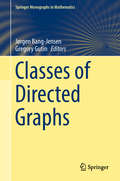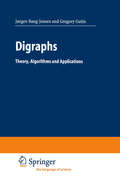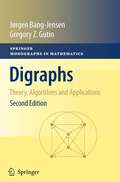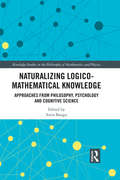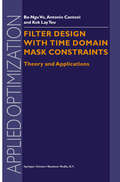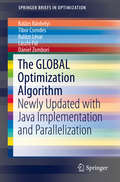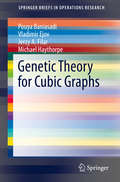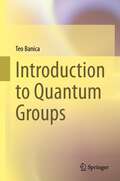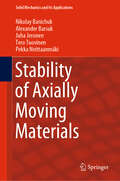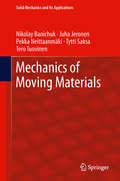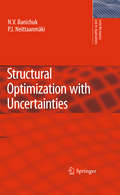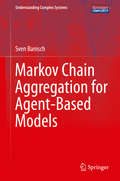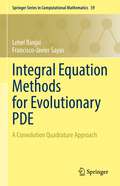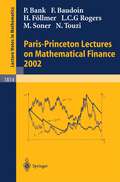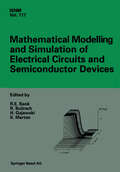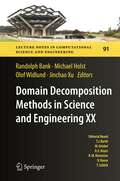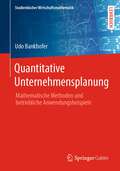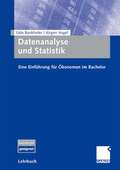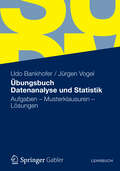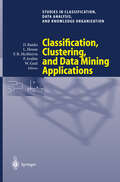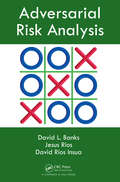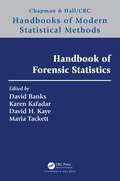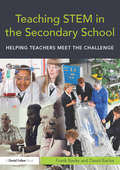- Table View
- List View
Classes of Directed Graphs (Springer Monographs in Mathematics)
by Jørgen Bang-Jensen Gregory GutinThis edited volume offers a detailed account of the theory of directed graphs from the perspective of important classes of digraphs, with each chapter written by experts on the topic. Outlining fundamental discoveries and new results obtained over recent years, this book provides a comprehensive overview of the latest research in the field. It covers core new results on each of the classes discussed, including chapters on tournaments, planar digraphs, acyclic digraphs, Euler digraphs, graph products, directed width parameters, and algorithms. Detailed indices ease navigation while more than 120 open problems and conjectures ensure that readers are immersed in all aspects of the field. Classes of Directed Graphs provides a valuable reference for graduate students and researchers in computer science, mathematics and operations research. As digraphs are an important modelling tool in other areas of research, this book will also be a useful resource to researchers working in bioinformatics, chemoinformatics, sociology, physics, medicine, etc.
Digraphs: Theory, Algorithms and Applications
by Jorgen Bang-Jensen Gregory Z. GutinThe study of directed graphs (digraphs) has developed enormously over recent decades, yet the results are rather scattered across the journal literature. This is the first book to present a unified and comprehensive survey of the subject. In addition to covering the theoretical aspects, the authors discuss a large number of applications and their generalizations to topics such as the traveling salesman problem, project scheduling, genetics, network connectivity, and sparse matrices. Numerous exercises are included. For all graduate students, researchers and professionals interested in graph theory and its applications, this book will be essential reading.
Digraphs: Theory, Algorithms and Applications (Springer Monographs in Mathematics)
by Jørgen Bang-Jensen Gregory Z. GutinSubstantially revised, reorganised and updated, the second edition now comprises eighteen chapters, carefully arranged in a straightforward and logical manner, with many new results and open problems. As well as covering the theoretical aspects of the subject, with detailed proofs of many important results, the authors present a number of algorithms, and whole chapters are devoted to topics such as branchings, feedback arc and vertex sets, connectivity augmentations, sparse subdigraphs with prescribed connectivity, and also packing, covering and decompositions of digraphs. Throughout the book, there is a strong focus on applications which include quantum mechanics, bioinformatics, embedded computing, and the travelling salesman problem. Detailed indices and topic-oriented chapters ease navigation, and more than 650 exercises, 170 figures and 150 open problems are included to help immerse the reader in all aspects of the subject.
Naturalizing Logico-Mathematical Knowledge: Approaches from Philosophy, Psychology and Cognitive Science (Routledge Studies in the Philosophy of Mathematics and Physics)
by Sorin BanguThis book is meant as a part of the larger contemporary philosophical project of naturalizing logico-mathematical knowledge, and addresses the key question that motivates most of the work in this field: What is philosophically relevant about the nature of logico-mathematical knowledge in recent research in psychology and cognitive science? The question about this distinctive kind of knowledge is rooted in Plato’s dialogues, and virtually all major philosophers have expressed interest in it. The essays in this collection tackle this important philosophical query from the perspective of the modern sciences of cognition, namely cognitive psychology and neuroscience. Naturalizing Logico-Mathematical Knowledge contributes to consolidating a new, emerging direction in the philosophy of mathematics, which, while keeping the traditional concerns of this sub-discipline in sight, aims to engage with them in a scientifically-informed manner. A subsequent aim is to signal the philosophers’ willingness to enter into a fruitful dialogue with the community of cognitive scientists and psychologists by examining their methods and interpretive strategies.
Naturalizing Logico-Mathematical Knowledge: Approaches from Philosophy, Psychology and Cognitive Science (Routledge Studies in the Philosophy of Mathematics and Physics)
by Sorin BanguThis book is meant as a part of the larger contemporary philosophical project of naturalizing logico-mathematical knowledge, and addresses the key question that motivates most of the work in this field: What is philosophically relevant about the nature of logico-mathematical knowledge in recent research in psychology and cognitive science? The question about this distinctive kind of knowledge is rooted in Plato’s dialogues, and virtually all major philosophers have expressed interest in it. The essays in this collection tackle this important philosophical query from the perspective of the modern sciences of cognition, namely cognitive psychology and neuroscience. Naturalizing Logico-Mathematical Knowledge contributes to consolidating a new, emerging direction in the philosophy of mathematics, which, while keeping the traditional concerns of this sub-discipline in sight, aims to engage with them in a scientifically-informed manner. A subsequent aim is to signal the philosophers’ willingness to enter into a fruitful dialogue with the community of cognitive scientists and psychologists by examining their methods and interpretive strategies.
Filter Design With Time Domain Mask Constraints: Theory and Applications (Applied Optimization #56)
by Ba-Ngu Vo Antonio Cantoni Kok Lay TeoOptimum envelope-constrained filter design is concerned with time-domain synthesis of a filter such that its response to a specific input signal stays within prescribed upper and lower bounds, while minimizing the impact of input noise on the filter output or the impact of the shaped signal on other systems depending on the application. In many practical applications, such as in TV channel equalization, digital transmission, and pulse compression applied to radar, sonar and detection, the soft least square approach, which attempts to match the output waveform with a specific desired pulse, is not the most suitable one. Instead, it becomes necessary to ensure that the response stays within the hard envelope constraints defined by a set of continuous inequality constraints. The main advantage of using the hard envelope-constrained filter formulation is that it admits a whole set of allowable outputs. From this set one can then choose the one which results in the minimization of a cost function appropriate to the application at hand. The signal shaping problems so formulated are semi-infinite optimization problems. This monograph presents in a unified manner results that have been generated over the past several years and are scattered in the research literature. The material covered in the monograph includes problem formulation, numerical optimization algorithms, filter robustness issues and practical examples of the application of envelope constrained filter design. Audience: Postgraduate students, researchers in optimization and telecommunications engineering, and applied mathematicians.
The GLOBAL Optimization Algorithm: Newly Updated With Java Implementation And Parallelization (SpringerBriefs in Optimization)
by Balázs Bánhelyi Tibor Csendes Balázs Lévai László Pál Dániel ZomboriThis book explores the updated version of the GLOBAL algorithm which contains improvements for a local search algorithm and new Java implementations. Efficiency comparisons to earlier versions and on the increased speed achieved by the parallelization, are detailed. Examples are provided for students as well as researchers and practitioners in optimization, operations research, and mathematics to compose their own scripts with ease. A GLOBAL manual is presented in the appendix to assist new users with modules and test functions. GLOBAL is a successful stochastic multistart global optimization algorithm that has passed several computational tests, and is efficient and reliable for small to medium dimensional global optimization problems. The algorithm uses clustering to ensure efficiency and is modular in regard to the two local search methods it starts with, but it can also easily apply other local techniques. The strength of this algorithm lies in its reliability and adaptive algorithm parameters. The GLOBAL algorithm is free to download also in the earlier Fortran, C, and MATLAB implementations.
Genetic Theory for Cubic Graphs (SpringerBriefs in Operations Research #0)
by Pouya Baniasadi Vladimir Ejov Jerzy A. Filar Michael HaythorpeThis book was motivated by the notion that some of the underlying difficulty in challenging instances of graph-based problems (e.g., the Traveling Salesman Problem) may be “inherited” from simpler graphs which – in an appropriate sense – could be seen as “ancestors” of the given graph instance. The authors propose a partitioning of the set of unlabeled, connected cubic graphs into two disjoint subsets named genes and descendants, where the cardinality of the descendants dominates that of the genes. The key distinction between the two subsets is the presence of special edge cut sets, called cubic crackers, in the descendants.The book begins by proving that any given descendant may be constructed by starting from a finite set of genes and introducing the required cubic crackers through the use of six special operations, called breeding operations. It shows that each breeding operation is invertible, and these inverse operations are examined. It is therefore possible, for any given descendant, to identify a family of genes that could be used to generate the descendant. The authors refer to such a family of genes as a “complete family of ancestor genes” for that particular descendant. The book proves the fundamental, although quite unexpected, result that any given descendant has exactly one complete family of ancestor genes. This result indicates that the particular combination of breeding operations used strikes the right balance between ensuring that every descendant may be constructed while permitting only one generating set.The result that any descendant can be constructed from a unique set of ancestor genes indicates that most of the structure in the descendant has been, in some way, inherited from that, very special, complete family of ancestor genes, with the remaining structure induced by the breeding operations. After establishing this, the authors proceed to investigate a number of graph theoretic properties: Hamiltonicity, bipartiteness, and planarity, and prove results linking properties of the descendant to those of the ancestor genes. They develop necessary (and in some cases, sufficient) conditions for a descendant to contain a property in terms of the properties of its ancestor genes. These results motivate the development of parallelizable heuristics that first decompose a graph into ancestor genes, and then consider the genes individually. In particular, they provide such a heuristic for the Hamiltonian cycle problem. Additionally, a framework for constructing graphs with desired properties is developed, which shows how many (known) graphs that constitute counterexamples of conjectures could be easily found.
Introduction to Quantum Groups
by Teo BanicaThis book introduces the reader to quantum groups, focusing on the simplest ones, namely the closed subgroups of the free unitary group.Although such quantum groups are quite easy to understand mathematically, interesting examples abound, including all classical Lie groups, their free versions, half-liberations, other intermediate liberations, anticommutation twists, the duals of finitely generated discrete groups, quantum permutation groups, quantum reflection groups, quantum symmetry groups of finite graphs, and more.The book is written in textbook style, with its contents roughly covering a one-year graduate course. Besides exercises, the author has included many remarks, comments and pieces of advice with the lone reader in mind. The prerequisites are basic algebra, analysis and probability, and a certain familiarity with complex analysis and measure theory. Organized in four parts, the book begins with the foundations of the theory, due to Woronowicz, comprising axioms, Haar measure, Peter–Weyl theory, Tannakian duality and basic Brauer theorems. The core of the book, its second and third parts, focus on the main examples, first in the continuous case, and then in the discrete case. The fourth and last part is an introduction to selected research topics, such as toral subgroups, homogeneous spaces and matrix models.Introduction to Quantum Groups offers a compelling introduction to quantum groups, from the simplest examples to research level topics.
Stability of Axially Moving Materials (Solid Mechanics and Its Applications #259)
by Nikolay Banichuk Alexander Barsuk Juha Jeronen Tero Tuovinen Pekka NeittaanmäkiThis book discusses the stability of axially moving materials, which are encountered in process industry applications such as papermaking. A special emphasis is given to analytical and semianalytical approaches. As preliminaries, we consider a variety of problems across mechanics involving bifurcations, allowing to introduce the techniques in a simplified setting. In the main part of the book, the fundamentals of the theory of axially moving materials are presented in a systematic manner, including both elastic and viscoelastic material models, and the connection between the beam and panel models. The issues that arise in formulating boundary conditions specifically for axially moving materials are discussed. Some problems involving axially moving isotropic and orthotropic elastic plates are analyzed. Analytical free-vibration solutions for axially moving strings with and without damping are derived. A simple model for fluid--structure interaction of an axially moving panel is presented in detail. This book is addressed to researchers, industrial specialists and students in the fields of theoretical and applied mechanics, and of applied and computational mathematics.
Mechanics of Moving Materials (Solid Mechanics and Its Applications #207)
by Nikolay Banichuk Juha Jeronen Pekka Neittaanmäki Tytti Saksa Tero TuovinenThis book deals with theoretical aspects of modelling the mechanical behaviour of manufacturing, processing, transportation or other systems in which the processed or supporting material is travelling through the system. Examples of such applications include paper making, transmission cables, band saws, printing presses, manufacturing of plastic films and sheets, and extrusion of aluminium foil, textiles and other materials.The work focuses on out-of-plane dynamics and stability analysis for isotropic and orthotropic travelling elastic and viscoelastic materials, with and without fluid-structure interaction, using analytical and semi-analytical approaches. Also topics such as fracturing and fatigue are discussed in the context of moving materials. The last part of the book deals with optimization problems involving physical constraints arising from the stability and fatigue analyses, including uncertainties in the parameters.The book is intended for researchers and specialists in the field, providing a view of the mechanics of axially moving materials. It can also be used as a textbook for advanced courses on this specific topic. Considering topics related to manufacturing and processing, the book can also be applied in industrial mathematics.
Structural Optimization with Uncertainties (Solid Mechanics and Its Applications #162)
by N.V. Banichuk Pekka NeittaanmäkiStructural optimization is currently attracting considerable attention. Interest in - search in optimal design has grown in connection with the rapid development of aeronautical and space technologies, shipbuilding, and design of precision mach- ery. A special ?eld in these investigations is devoted to structural optimization with incomplete information (incomplete data). The importance of these investigations is explained as follows. The conventional theory of optimal structural design - sumes precise knowledge of material parameters, including damage characteristics and loadings applied to the structure. In practice such precise knowledge is seldom available. Thus, it is important to be able to predict the sensitivity of a designed structure to random ?uctuations in the environment and to variations in the material properties. To design reliable structures it is necessary to apply the so-called gu- anteed approach, based on a “worst case scenario” or a more optimistic probabilistic approach, if we have additional statistical data. Problems of optimal design with incomplete information also have consid- able theoretical importance. The introduction and investigations into new types of mathematical problems are interesting in themselves. Note that some ga- theoretical optimization problems arise for which there are no systematic techniques of investigation. This monograph is devoted to the exposition of new ways of formulating and solving problems of structural optimization with incomplete information. We recall some research results concerning the optimum shape and structural properties of bodies subjected to external loadings.
Markov Chain Aggregation for Agent-Based Models (Understanding Complex Systems)
by Sven BanischThis self-contained text develops a Markov chain approach that makes the rigorous analysis of a class of microscopic models that specify the dynamics of complex systems at the individual level possible. It presents a general framework of aggregation in agent-based and related computational models, one which makes use of lumpability and information theory in order to link the micro and macro levels of observation. The starting point is a microscopic Markov chain description of the dynamical process in complete correspondence with the dynamical behavior of the agent-based model (ABM), which is obtained by considering the set of all possible agent configurations as the state space of a huge Markov chain. An explicit formal representation of a resulting “micro-chain” including microscopic transition rates is derived for a class of models by using the random mapping representation of a Markov process. The type of probability distribution used to implement the stochastic part of the model, which defines the updating rule and governs the dynamics at a Markovian level, plays a crucial part in the analysis of “voter-like” models used in population genetics, evolutionary game theory and social dynamics. The book demonstrates that the problem of aggregation in ABMs - and the lumpability conditions in particular - can be embedded into a more general framework that employs information theory in order to identify different levels and relevant scales in complex dynamical systems
Integral Equation Methods for Evolutionary PDE: A Convolution Quadrature Approach (Springer Series in Computational Mathematics #59)
by Lehel Banjai Francisco-Javier SayasThis book provides a comprehensive analysis of time domain boundary integral equations and their discretisation by convolution quadrature and the boundary element method.Properties of convolution quadrature, based on both linear multistep and Runge–Kutta methods, are explained in detail, always with wave propagation problems in mind. Main algorithms for implementing the discrete schemes are described and illustrated by short Matlab codes; translation to other languages can be found on the accompanying GitHub page. The codes are used to present numerous numerical examples to give the reader a feeling for the qualitative behaviour of the discrete schemes in practice. Applications to acoustic and electromagnetic scattering are described with an emphasis on the acoustic case where the fully discrete schemes for sound-soft and sound-hard scattering are developed and analysed in detail. A strength of the book is that more advanced applications such as linear and non-linear impedance boundary conditions and FEM/BEM coupling are also covered. While the focus is on wave scattering, a chapter on parabolic problems is included which also covers the relevant fast and oblivious algorithms. Finally, a brief description of data sparse techniques and modified convolution quadrature methods completes the book.Suitable for graduate students and above, this book is essentially self-contained, with background in mathematical analysis listed in the appendix along with other useful facts. Although not strictly necessary, some familiarity with boundary integral equations for steady state problems is desirable.
Paris-Princeton Lectures on Mathematical Finance 2002 (Lecture Notes in Mathematics #1814)
by Peter Bank Fabrice Baudoin Hans Föllmer L. C. Rogers Halil Mete Soner Nizar TouziThe Paris-Princeton Lectures in Financial Mathematics, of which this is the first volume, will, on an annual basis, publish cutting-edge research in self-contained, expository articles from outstanding - established or upcoming! - specialists. The aim is to produce a series of articles that can serve as an introductory reference for research in the field. It arises as a result of frequent exchanges between the finance and financial mathematics groups in Paris and Princeton. The present volume sets standards with articles by P. Bank/H. Föllmer, F. Baudoin, L.C.G. Rogers, and M. Soner/N. Touzi.
Mathematical Modelling and Simulation of Electrical Circuits and Semiconductor Devices: Proceedings of a Conference held at the Mathematisches Forschungsinstitut, Oberwolfach, July 5–11, 1992 (International Series of Numerical Mathematics #117)
by Randolph Bank R. Bulirsch H. Gajewski K. MertenProgress in today's high-technology industries is strongly associated with the development of new mathematical tools. A typical illustration of this partnership is the mathematical modelling and numerical simulation of electric circuits and semiconductor devices. At the second Oberwolfach conference devoted to this important and timely field, scientists from around the world, mainly applied mathematicians and electrical engineers from industry and universities, presented their new results. Their contributions, forming the body of this work, cover electric circuit simulation, device simulation and process simulation. Discussions on experiences with standard software packages and improvements of such packages are included. In the semiconductor area special lectures were given on new modelling approaches, numerical techniques and existence and uniqueness results. In this connection, mention is made, for example, of mixed finite element methods, an extension of the Baliga-Patankar technique for a three dimensional simulation, and the connection between semiconductor equations and the Boltzmann equations.
Domain Decomposition Methods in Science and Engineering XX (Lecture Notes in Computational Science and Engineering #91)
by Randolph Bank Michael Holst Olof Widlund Jinchao XuThese are the proceedings of the 20th international conference on domain decomposition methods in science and engineering. Domain decomposition methods are iterative methods for solving the often very large linearor nonlinear systems of algebraic equations that arise when various problems in continuum mechanics are discretized using finite elements. They are designed for massively parallel computers and take the memory hierarchy of such systems in mind. This is essential for approaching peak floating point performance. There is an increasingly well developed theory whichis having a direct impact on the development and improvements of these algorithms.
Quantitative Unternehmensplanung: Mathematische Methoden und betriebliche Anwendungsbeispiele (Studienbücher Wirtschaftsmathematik)
by Udo BankhoferDas Lehrbuch führt anwendungsorientiert in alle zentralen Teilbereiche des Operations Research bzw. der quantitativen Unternehmensplanung ein: Behandelt werden lineare, ganzzahlige und nichtlineare Optimierungsansätze, Methoden der Projektplanung und Netzplantechnik, stochastische Modelle sowie nichtexakte Lösungsverfahren. Die jeweiligen Modelle und Methoden werden anhand zahlreicher betrieblicher Anwendungsbeispiele aus den Bereichen Produktion, Logistik, Marketing und Finanzwirtschaft illustriert. Entsprechende Übungsaufgaben mit ausführlichen Lösungen tragen zur Vertiefung des Stoffes bei und helfen bei der Vorbereitung auf Klausuren. Das Buch richtet sich an Lehrende und Studierende der Wirtschaftswissenschaften, der Wirtschaftsinformatik, der Ingenieurwissenschaften sowie verwandter Studiengänge, in denen grundlegende Kenntnisse quantitativer Methoden der Unternehmensplanung benötigt werden.
Datenanalyse und Statistik: Eine Einführung für Ökonomen im Bachelor
by Udo Bankhofer Jürgen VogelDas Buch deckt den Bereich der Datenanalyse und Statistik in seiner ganzen Breite ab. Neben der deskriptiven und induktiven Statistik werden insbesondere Methoden der Datenanalyse sowie neuere Ansätze des Data Mining behandelt. Zahlreiche Beispiele ergänzen die methodischen Darstellungen.
Übungsbuch Datenanalyse und Statistik: Aufgaben - Musterklausuren - Lösungen
by Udo Bankhofer Jürgen VogelDieses Buch ermöglicht eine Vertiefung grundlegender Begriffe und Verfahren zu den Themen Statistik und Datenanalyse und ist ein unverzichtbarer Begleiter zum Selbststudium und zur Prüfungsvorbereitung. Es enthält zahlreiche Übungsaufgaben,komplette Klausuren und ausführliche Lösungen. Nahezu alle Aufgaben stellen dabei realistische Problemstellungen und Anwendungsbereiche dar. Die Klausuren zeigen neben Zeitvorgaben und Lösungen auch die Punkteverteilungen der einzelnen Aufgaben, um eine entsprechende Leistungseinstufung vornehmen zu können.
Classification, Clustering, and Data Mining Applications: Proceedings of the Meeting of the International Federation of Classification Societies (IFCS), Illinois Institute of Technology, Chicago, 15–18 July 2004 (Studies in Classification, Data Analysis, and Knowledge Organization)
by David Banks Wolfgang A. Gaul Leanna House Frederick R. McMorris Phipps ArabieThis volume describes new methods with special emphasis on classification and cluster analysis. These methods are applied to problems in information retrieval, phylogeny, medical diagnosis, microarrays, and other active research areas.
Adversarial Risk Analysis
by David L. Banks Jesus M. Aliaga David Rios InsuaWinner of the 2017 De Groot Prize awarded by the International Society for Bayesian Analysis (ISBA)A relatively new area of research, adversarial risk analysis (ARA) informs decision making when there are intelligent opponents and uncertain outcomes. Adversarial Risk Analysis develops methods for allocating defensive or offensive resources against
Handbook of Forensic Statistics (ISSN)
by David L. Banks Karen Kafadar David H. Kaye Maria TackettHandbook of Forensic Statistics is a collection of chapters by leading authorities in forensic statistics. Written for statisticians, scientists, and legal professionals having a broad range of statistical expertise, it summarizes and compares basic methods of statistical inference (frequentist, likelihoodist, and Bayesian) for trace and other evidence that links individuals to crimes, the modern history and key controversies in the field, and the psychological and legal aspects of such scientific evidence.Specific topics include uncertainty in measurements and conclusions; statistically valid statements of weight of evidence or source conclusions; admissibility and presentation of statistical findings; and the state of the art of methods (including problems and pitfalls) for collecting, analyzing, and interpreting data in such areas as forensic biology, chemistry, and pattern and impression evidence. The particular types of evidence that are discussed include DNA, latent fingerprints, firearms and toolmarks, glass, handwriting, shoeprints, and voice exemplars.
Teaching STEM in the Secondary School: Helping teachers meet the challenge
by Frank Banks David BarlexThe skills, knowledge and understanding of the subjects involved in STEM (Science, Technology, Engineering and Mathematics) are vital for all young people in an increasingly science- and technology-driven society. This book looks at the purpose and pedagogy of STEM teaching and explores the ways in which STEM subjects can interact in the curriculum to enhance student understanding, achievement and motivation. By reaching outside their own classroom, teachers can collaborate across subjects to enrich learning and help students relate school science, technology and maths to the wider world. Packed with ideas and practical details for teachers of STEM subjects, this book: considers what the STEM subjects contribute separately to the curriculum and how they relate to each other in the wider education of secondary school students describes and evaluates different curriculum models for STEM suggests ways in which a critical approach to the pedagogy of the classroom, laboratory and workshop can support STEM for all students addresses the practicalities of introducing, organising and sustaining STEM-related activities in the secondary school looks to ways schools can manage and sustain STEM approaches in the long-term. This timely new text is essential reading for trainee and practising teachers who wish to make the learning of Science, Technology, Engineering and Mathematics an interesting, motivating and exciting experience for their students.
Teaching STEM in the Secondary School: Helping teachers meet the challenge
by Frank Banks David BarlexThe skills, knowledge and understanding of the subjects involved in STEM (Science, Technology, Engineering and Mathematics) are vital for all young people in an increasingly science- and technology-driven society. This book looks at the purpose and pedagogy of STEM teaching and explores the ways in which STEM subjects can interact in the curriculum to enhance student understanding, achievement and motivation. By reaching outside their own classroom, teachers can collaborate across subjects to enrich learning and help students relate school science, technology and maths to the wider world. Packed with ideas and practical details for teachers of STEM subjects, this book: considers what the STEM subjects contribute separately to the curriculum and how they relate to each other in the wider education of secondary school students describes and evaluates different curriculum models for STEM suggests ways in which a critical approach to the pedagogy of the classroom, laboratory and workshop can support STEM for all students addresses the practicalities of introducing, organising and sustaining STEM-related activities in the secondary school looks to ways schools can manage and sustain STEM approaches in the long-term. This timely new text is essential reading for trainee and practising teachers who wish to make the learning of Science, Technology, Engineering and Mathematics an interesting, motivating and exciting experience for their students.
